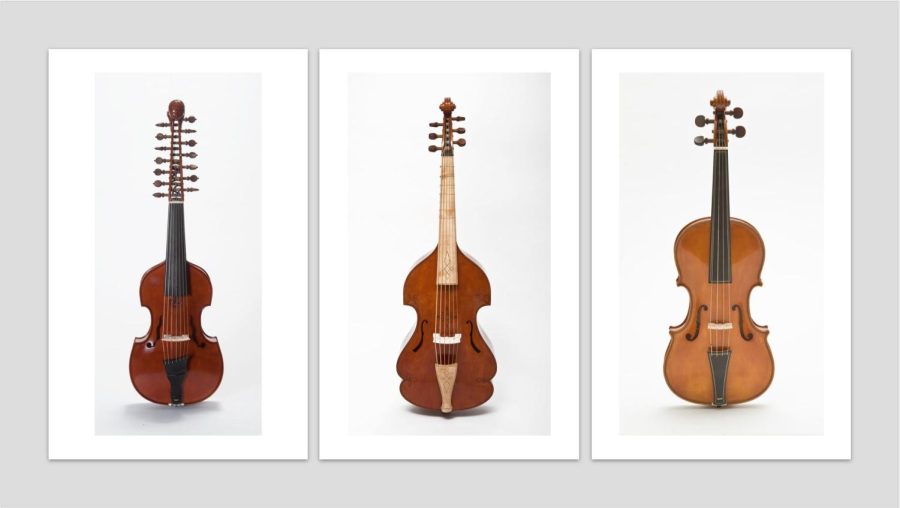Musician, Devin Hough, gives a rare glimpse into the history and modernization of baroque-era string instruments
The violin marked a major transformation in music, characterized by the infusion of drama, emotion, and tonality
Devin Hough, luthier and musician, has dedicated his life to building and repairing string instruments, including baroque-era violins, viola d’amores, and violones. (Photo courtesy of Devin Hough)
These days, working as a luthier, a maker of stringed instruments, is an unusual profession. Over time, the craft has largely been replaced by mass production in an age that often values efficiency over craftsmanship.
Devin Hough, Davis resident and maker of handmade violins, violas, and cellos in both modern and baroque forms, gave audiences a tour of his workshop during the Cosumnes River College music event, “Music: In the Studio,” on Feb 4.
Lisa Beebe, Cosumnes River College music professor and host of “Music: In the Studio,” previously had Hough fix one of her violas da gamba.
“During a trip to his workshop, I was so impressed with the wide variety of musical instruments he has built and repaired as well as his historical knowledge of these instruments,” Beebe said in an email to The Current.
Appreciating the art of instrument-making requires an understanding of the history surrounding it.
“You may have heard of Antonio Vivaldi, an Italian priest and himself a fantastic violin virtuoso,” Hough said in an email to The Current. “Much of his music is currently heard in movie soundtracks and elsewhere.”
Vivaldi’s 300-year-old piece, “Concerto for 2 Violins in G major,” was featured in the latest theatrical hit, “Spider-Man: No Way Home.”
Vivaldi, alongside German composer and musician Johan Sebastian Bach, were products of the baroque era of music. This period spanned from the early 17th century to the mid-18th century.
The introduction and evolution of the violin marked a major transformation in music, characterized by the infusion of drama, emotion, and tonality into music.
“Within the violin family, which has continued from the early 16th century to the present, subtle changes were made in the 19th century, primarily to make the sound louder,” Hough said. “This was necessary to accommodate the bigger orchestras, concert halls, and audiences.”
Hough’s interest in classical music and building period instruments primarily came from his parents and spending summers watching and helping his grandfather, who was a violin maker himself.
“A lot of that interest was visual, looking through his books,” Hough said. “The amazing variety of forms, shapes, and decorations embodied in these lutes, violas da gamba, violas d’amore, and many other kinds of instruments from that [baroque] period.”
One summer, he and his grandfather built one. Even though his contribution was limited to rough work and some sanding, his enthusiasm for the experience was recognizable.
Hough has a vivid memory of brushing on the varnish on his grandfather’s instruments and the thrill he felt when stringing it up hearing it for the first time.
The process of building and transforming an instrument is something that takes years to master. Hough gave a simple and quick breakdown of his process.
The body of the instrument is assembled by carving and joining the top, ribs, and back of the instrument. Hough also uses his motorized jigsaw, gouges and chisels to cut, shave, and scrape the wood into its final form.
“Most of these tools are European,” Hough said. “These calipers are made in Germany and they’ll measure…thickness to a tenth of a millimeter.”
Hough gave a side-by-side comparison of what a baroque and modern viola sounded like and Beebe was there to hear it.
“Since the viola is my instrument, it meant even more to hear this difference in an instrument with which I’m already so familiar,” Beebe said. “It was almost like hearing an old friend speaking with a different accent.”
According to Hough, the European spruce and maple wood, used to build the body and neck of these instruments, are generally easy to come by.
However, there is some concern for an endangered South American rainforest hardwood Pernambuco, says Hough. This wood is used in making top-quality bows but is rarely used in baroque style bows.
“The American Federation of Violin and Bow Makers, a group in which I am a member, has a number of truly amazing bow makers,” Hough said. “And they have a vital interest in making sure that the wood they require for the continuation of their craft continues to be available.”
Hough now does a lot of repairs and modifications on string instruments, including converting them from modern to baroque form and vice versa. His expertise in early music developed into a passion through the unique visual designs and acoustic characteristics of each instrument.
With this passion comes the enthusiasm to share his knowledge with students and musicians. Through “Music: In the Studio,” Hough was able to do just that.











